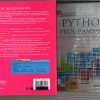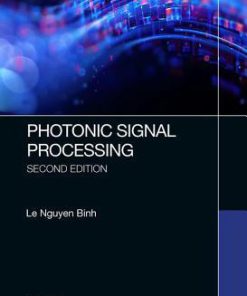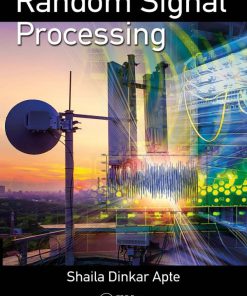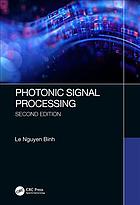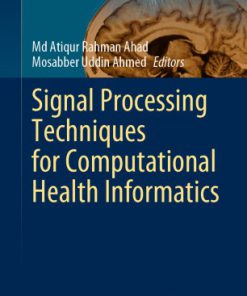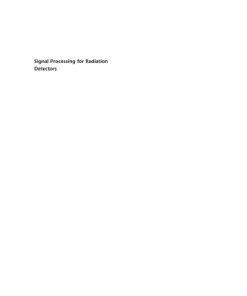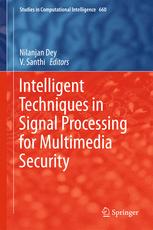Signal Processing for Neuroscientists An Introduction to the Analysis of Physiological Signals 2nd Edition by Wim van Drongelen ISBN 012810483X 9780128104835
$50.00 Original price was: $50.00.$25.00Current price is: $25.00.
Signal Processing for Neuroscientists An Introduction to the Analysis of Physiological Signals 2nd Edition by Wim van Drongelen – Ebook PDF Instant Download/Delivery: 012810483X, 9780128104835
Full download Signal Processing for Neuroscientists An Introduction to the Analysis of Physiological Signals 2nd Edition after payment
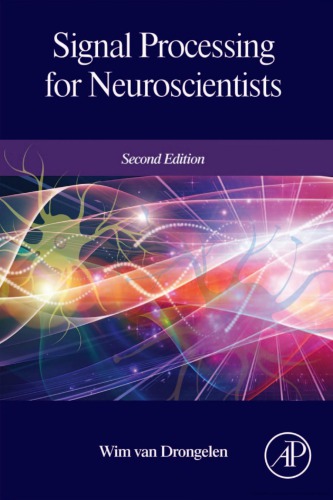
Product details:
ISBN 10: 012810483X
ISBN 13: 9780128104835
Author: Wim van Drongelen
Signal Processing for Neuroscientists, Second Edition provides an introduction to signal processing and modeling for those with a modest understanding of algebra, trigonometry and calculus. With a robust modeling component, this book describes modeling from the fundamental level of differential equations all the way up to practical applications in neuronal modeling. It features nine new chapters and an exercise section developed by the author. Since the modeling of systems and signal analysis are closely related, integrated presentation of these topics using identical or similar mathematics presents a didactic advantage and a significant resource for neuroscientists with quantitative interest.
Although each of the topics introduced could fill several volumes, this book provides a fundamental and uncluttered background for the non-specialist scientist or engineer to not only get applications started, but also evaluate more advanced literature on signal processing and modeling.
- Includes an introduction to biomedical signals, noise characteristics, recording techniques, and the more advanced topics of linear, nonlinear and multi-channel systems analysis
- Features new chapters on the fundamentals of modeling, application to neuronal modeling, Kalman filter, multi-taper power spectrum estimation, and practice exercises
- Contains the basics and background for more advanced topics in extensive notes and appendices
- Includes practical examples of algorithm development and implementation in MATLAB
- Features a companion website with MATLAB scripts, data files, figures and video lectures
Signal Processing for Neuroscientists An Introduction to the Analysis of Physiological Signals 2nd Table of contents:
Chapter 1. Introduction
1.1. Overview
1.2. Biomedical Signals
1.3. Biopotentials
1.4. Examples of Biomedical Signals
1.5. Analog-to-Digital Conversion
1.6. Moving Signals Into the MATLAB® Analysis Environment
Appendix 1.1
Exercises
Chapter 2. Data Acquisition
2.1. Rationale
2.2. The Measurement Chain
2.3. Sampling and Nyquist Frequency in the Frequency Domain
2.4. The Move to the Digital Domain
Appendix 2.1
Exercises
Chapter 3. Noise
3.1. Introduction
3.2. Noise Statistics
3.3. Signal-to-Noise Ratio
3.4. Noise Sources
Appendix 3.1
Appendix 3.2
Appendix 3.3
Appendix 3.4
Appendix 3.5 Laplace and Fourier Transforms of Probability Density Functions
Exercises
Chapter 4. Signal Averaging
4.1. Introduction
4.2. Time-Locked Signals
4.3. Signal Averaging and Random Noise
4.4. Noise Estimates
4.5. Signal Averaging and Nonrandom Noise
4.6. Noise as a Friend of the Signal Averager
4.7. Evoked Potentials
4.8. Overview of Commonly Applied Time Domain Analysis Techniques
Appendix 4.1 Expectation of the Product of Independent Random Variables
Exercises
Chapter 5. Real and Complex Fourier Series
5.1. Introduction
5.2. The Fourier Series
5.3. The Complex Fourier Series
Examples
Appendix 5.1
Appendix 5.2
Exercises
Chapter 6. Continuous, Discrete, and Fast Fourier Transform
6.1. Introduction
6.2. The Fourier Transform
6.3. Discrete Fourier Transform and the Fast Fourier Transform Algorithm
Exercises
Chapter 7. 1-D and 2-D Fourier Transform Applications
7.1. Spectral Analysis
7.2. Two-Dimensional Fourier Transform Applications in Imaging
Appendix 7.1
Exercises
Chapter 8. Lomb’s Algorithm and Multitaper Power Spectrum Estimation
8.1. Overview
8.2. Unevenly Sampled Data
8.3. Errors in the Periodogram
Appendix 8.1
Appendix 8.2
Exercises
Chapter 9. Differential Equations: Introduction
9.1. Modeling Dynamics
9.2. How to Formulate an Ordinary Differential Equation
9.3. Solving First- and Second-Order Ordinary Differential Equations
9.4. Ordinary Differential Equations With a Forcing Term
9.5. Representation of Higher-Order Ordinary Differential Equations as a Set of First-Order Ones
9.6. Transforms to Solve Ordinary Differential Equations
Exercises
Chapter 10. Differential Equations: Phase Space and Numerical Solutions
10.1. Graphical Representation of Flow and Phase Space
10.2. Numerical Solution of an ODE
10.3. Partial Differential Equations
Exercises
Chapter 11. Modeling
11.1. Introduction
11.2. Different Types of Models
11.3. Examples of Parametric and Nonparametric Models
11.4. Polynomials
11.5. Nonlinear Systems With Memory
Appendix 11.1
Exercises
Chapter 12. Laplace and z-Transform
12.1. Introduction
12.2. The Use of Transforms to Solve Ordinary Differential Equations
12.3. The Laplace Transform
12.4. Examples of the Laplace Transform
12.5. The z-Transform
12.6. The z-Transform and Its Inverse
12.7. Example of the z-Transform
Appendix 12.1
Appendix 12.2
Appendix 12.3
Exercises
Chapter 13. LTI Systems: Convolution, Correlation, Coherence, and the Hilbert Transform
13.1. Introduction
13.2. Linear Time-Invariant System
13.3. Convolution
13.4. Autocorrelation and Cross-Correlation
13.5. Coherence
13.6. The Hilbert Transform
Appendix 13.1
Appendix 13.2
Appendix 13.3
Exercises
Chapter 14. Causality
14.1. Introduction
14.2. Granger Causality
14.3. Directed Transfer Function
14.4. Applications of Causal Analysis
Exercises
Chapter 15. Introduction to Filters: The RC-Circuit
15.1. Introduction
15.2. Filter Types and Their Frequency Domain Characteristics
15.3. Recipe for an Experiment With an RC-Circuit
Exercise
Chapter 16. Filters: Analysis
16.1. Introduction
16.2. The RC Circuit
16.3. The Experimental Data
Appendix 16.1
Appendix 16.2
Appendix 16.3
Exercises
Chapter 17. Filters: Specification, Bode Plot, Nyquist Plot
17.1. Introduction: Filters as Linear Time-Invariant Systems
17.2. Time Domain Response
17.3. The Frequency Characteristic
17.4. Noise and the Filter Frequency Response
Exercises
Chapter 18. Filters: Digital Filters
18.1. Introduction
18.2. Infinite Impulse Response and Finite Impulse Response Digital Filters
18.3. Autoregressive, Moving Average, and ARMA Filters
18.4. Frequency Characteristics of Digital Filters
18.5. MATLAB® Implementation
18.6. Filter Types
18.7. Filter Bank
18.8. Filters in the Spatial Domain
Appendix 18.1
Exercises
Chapter 19. Kalman Filter
19.1. Introduction
19.2. Introductory Terminology
19.3. Derivation of a Kalman Filter for a Simple Case
19.4. Matlab® Example
19.5. Use of the Kalman Filter to Estimate Model Parameters
Appendix 19.1 Details of the Steps Between Eqs. (19.17) and (19.18)
Exercises
Chapter 20. Spike Train Analysis
20.1. Introduction
20.2. Poisson Processes and Poisson Distributions
20.3. Entropy and Information
20.4. The Autocorrelation Function
20.5. Cross-Correlation
Appendix 20.1
Appendix 20.2
Exercises
Chapter 21. Wavelet Analysis: Time Domain Properties
21.1. Introduction
21.2. Wavelet Transform
21.3. Other Wavelet Functions
21.4. 2-D Application
Appendix 21.1
Appendix 21.2
Exercises
Chapter 22. Wavelet Analysis: Frequency Domain Properties
22.1. Introduction
22.2. The Continuous Wavelet Transform
22.3. Time–Frequency Resolution
22.4. MATLAB® Wavelet Examples
Appendix 22.1
Exercises
Chapter 23. Low-Dimensional Nonlinear Dynamics: Fixed Points, Limit Cycles, and Bifurcations
23.1. Introduction
23.2. Nonlinear Dynamics in Continuous and Discrete Time
23.3. Effects of Parameter Selection on Linear and Nonlinear Systems
23.4. Application to Modeling Neural Excitability
23.5. Codimension-2 Bifurcations
Appendix 23.1
Exercises
Chapter 24. Volterra Series
24.1. Introduction
24.2. Volterra Series
24.3. A Second-Order Volterra System
24.4. General Second-Order System
24.5. System Tests for Internal Structure
24.6. Sinusoidal Signals
Exercises
Chapter 25. Wiener Series
25.1. Introduction
25.2. Wiener Kernels
25.3. Determination of the Zeroth-, First-, and Second-Order Wiener Kernels
25.4. Implementation of the Cross-Correlation Method
25.5. Relation Between Wiener and Volterra Kernels
25.6. Analyzing Spiking Neurons Stimulated With Noise
25.7. Nonwhite Gaussian Input
25.8. Summary
Appendix 25.1
Appendix 25.2
Exercises
Chapter 26. Poisson–Wiener Series
26.1. Introduction
26.2. Systems With Impulse Train Input
26.3. Determination of the Zeroth-, First-, and Second-Order Poisson–Wiener Kernels
26.4. Implementation of the Cross-Correlation Method
26.5. Spiking Output
26.6. Summary
Appendix 26.1
Appendix 26.2
Exercises
Chapter 27. Nonlinear Techniques
27.1. Introduction
27.2. Nonlinear Deterministic Processes
27.3. Linear Techniques Fail to Describe Nonlinear Dynamics
27.4. Embedding
27.5. Metrics for Characterizing Nonlinear Processes
27.6. Application to Brain Electrical Activity
Exercises
Chapter 28. Decomposition of Multichannel Data
28.1. Introduction
28.2. Mixing and Unmixing of Signals
28.3. Principal Component Analysis
28.4. Independent Component Analysis
Exercises
Chapter 29. Modeling Neural Systems: Cellular Models
29.1. Introduction
29.2. The Hodgkin and Huxley Formalism
29.3. Models That Can Be Derived From the Hodgkin and Huxley Formalism
Appendix 29.1
Appendix 29.2 Building the Integrate-and-Fire Circuit
Exercises
Chapter 30. Modeling Neural Systems: Network Models
30.1. Introduction
30.2. Networks of Individual Cell Models
30.3. Mean Field Network Models
30.4. Spatiotemporal Model for the Electroencephalogram
30.5. A Field Equation for the Electroencephalogram
30.6. Models With a Stochastic Component
30.7. Concluding Remarks
People also search for Signal Processing for Neuroscientists An Introduction to the Analysis of Physiological Signals 2nd:
signal processing for neuroscientists drongelen
signal processing for neuroscientists by wim van drongelen
is signal processing in demand
signal processing companies
signal processing for neuroscientists
Tags:
Wim van Drongelen,Signal Processing,Neuroscientists,Analysis,Physiological Signals
You may also like…
Engineering
Engineering - Electrical & Electronic Engineering
Signal Processing For Radiation Detectors 1st Edition by Mohammad Nakhostin 1119410169 9781119410164
Computers
Intelligent Techniques in Signal Processing for Multimedia Security 1st Edition Nilanjan Dey
Engineering
Fundamentals of Signal Enhancement and Array Signal Processing 1st Edition Jacob Benesty
Engineering
Radiation Hardened CMOS Integrated Circuits for Time Based Signal Processing Jeffrey Prinzie


